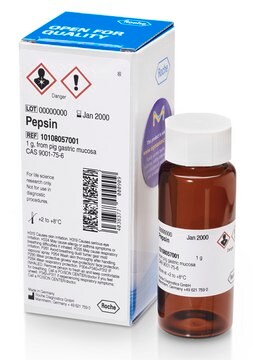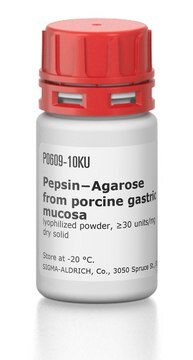SRE0001
Pepsine from porcine gastric mucosa
Suitable for manufacturing of diagnostic kits and reagents, lyophilized powder, ≥3200 units/mg protein
Synonyme(s) :
Pepsine from hog stomach, Pepsine A
About This Item
Produits recommandés
Niveau de qualité
Forme
lyophilized powder
Activité spécifique
≥3200 units/mg protein
Poids mol.
35 kDa
Impuretés
salt, essentially free
Couleur
white to off-white
Numéro d'accès UniProt
Application(s)
diagnostic assay manufacturing
Conditions d'expédition
wet ice
Température de stockage
−20°C
Informations sur le gène
pig ... LOC396892(396892)
Vous recherchez des produits similaires ? Visite Guide de comparaison des produits
Application
Actions biochimiques/physiologiques
Définition de l'unité
Remarque sur l'analyse
Autres remarques
Inhibiteur
Mention d'avertissement
Danger
Mentions de danger
Conseils de prudence
Classification des risques
Eye Irrit. 2 - Resp. Sens. 1 - Skin Irrit. 2 - STOT SE 3
Organes cibles
Respiratory system
Code de la classe de stockage
11 - Combustible Solids
Classe de danger pour l'eau (WGK)
WGK 1
Point d'éclair (°F)
Not applicable
Point d'éclair (°C)
Not applicable
Certificats d'analyse (COA)
Recherchez un Certificats d'analyse (COA) en saisissant le numéro de lot du produit. Les numéros de lot figurent sur l'étiquette du produit après les mots "Lot" ou "Batch".
Déjà en possession de ce produit ?
Retrouvez la documentation relative aux produits que vous avez récemment achetés dans la Bibliothèque de documents.
Les clients ont également consulté
Notre équipe de scientifiques dispose d'une expérience dans tous les secteurs de la recherche, notamment en sciences de la vie, science des matériaux, synthèse chimique, chromatographie, analyse et dans de nombreux autres domaines..
Contacter notre Service technique







